By Curtis Russell
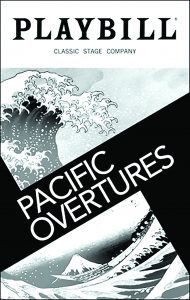 In the 1970s, the creative partnership of composer/lyricist Stephen Sondheim and director Hal Prince revolutionized the Broadway musical. Both of them were mentored by the leading lights of Broadway’s Golden Age: Sondheim by lyricist/librettist Oscar Hammerstein II (Oklahoma!, Carousel, The Sound of Music) and Prince by director George Abbott (On the Town, The Pajama Game, Damn Yankees). Sondheim inherited Hammerstein’s rigorous craft and narrative precision, which he deepened with inventive compositions that were clear enough to clock on first listen and yet demonstrated an intricate complexity that rewarded repeated exposure. Prince combined the showmanship he gleaned from Abbott with a social engagement and radical staging techniques inspired by the twentieth-century Russian Symbolist Vsevolod Meyerhold to create a unique theatrical alchemy. While Sondheim and Prince’s work was too distinctive to engender a new trend in musical theatre production, it expanded the artistic and thematic limits of the form.
In the 1970s, the creative partnership of composer/lyricist Stephen Sondheim and director Hal Prince revolutionized the Broadway musical. Both of them were mentored by the leading lights of Broadway’s Golden Age: Sondheim by lyricist/librettist Oscar Hammerstein II (Oklahoma!, Carousel, The Sound of Music) and Prince by director George Abbott (On the Town, The Pajama Game, Damn Yankees). Sondheim inherited Hammerstein’s rigorous craft and narrative precision, which he deepened with inventive compositions that were clear enough to clock on first listen and yet demonstrated an intricate complexity that rewarded repeated exposure. Prince combined the showmanship he gleaned from Abbott with a social engagement and radical staging techniques inspired by the twentieth-century Russian Symbolist Vsevolod Meyerhold to create a unique theatrical alchemy. While Sondheim and Prince’s work was too distinctive to engender a new trend in musical theatre production, it expanded the artistic and thematic limits of the form.
The boldest formal experiment of Sondheim and Prince’s astonishing decade was 1976’s Pacific Overtures, which end eavored to tell the tale of the westernization of Japan in a hybrid Broadway/kabuki staging. Questioning Usonian Interventionism in the bicentennial year with an uneasy mix of East an
eavored to tell the tale of the westernization of Japan in a hybrid Broadway/kabuki staging. Questioning Usonian Interventionism in the bicentennial year with an uneasy mix of East an
d West, the elaborate production, which featured a kabuki-appropriate all-male cast of Asian descent, struggled to find enough of an audience to fill the massive Wint
er Garden Theatre on Broadway between 50th and 51st Streets (currently home to Andrew Lloyd Webber’s rather less inventive School of Rock) and limped to a close after only six months of performances. The show’s musical complexity and casting requirements have made it less revivable than others in the Sondheim canon, but a lush original cast recording ensured its place in the pantheon.
Following a high profile but short-lived Broadway re-staging at Studio 54 in late 2004, Pacific Overtures is being given a lean revival downtown at the Classic Stage Company through May 27, directed by John Doyle. Our current troubled moment seems apposite for this politicized work, and while Doyle’s production makes a strong case for Sondheim’s continued musical theatre supremacy, it never quite manages to answer the key question undergirding every theatrical venture: why this play now?
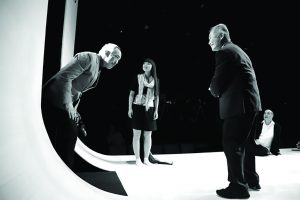 Pacific Overtures, with a libretto by John Weidman (who also wrote Sondheim’s other overtly political musical, 1990’s Assassins) narrates its mid-nineteenth century story from a multiplicity of viewpoints, including a Reciter (Star Trek legend and internet meme guru, George Takei), Shogun Lord Abe (Thom Sesma), a Kanagawa madam (comedy queen, Ann Harada, importing her Avenue Q snark by the truckload), a thief (Marc Oka), and a warrior (Kelvin Moon Loh, pulling quadruple duty as a sailor, a Russian admiral, and a prostitute—most of the cast play multiple roles).
Pacific Overtures, with a libretto by John Weidman (who also wrote Sondheim’s other overtly political musical, 1990’s Assassins) narrates its mid-nineteenth century story from a multiplicity of viewpoints, including a Reciter (Star Trek legend and internet meme guru, George Takei), Shogun Lord Abe (Thom Sesma), a Kanagawa madam (comedy queen, Ann Harada, importing her Avenue Q snark by the truckload), a thief (Marc Oka), and a warrior (Kelvin Moon Loh, pulling quadruple duty as a sailor, a Russian admiral, and a prostitute—most of the cast play multiple roles).
The closest thing the play has to a protagonist is Kayama (Steven Eng), who develops a friendship with Manjiro (Orville Mendoza), a fisherman who has spent time in America. Kayama, a minor samurai, enlists Manjiro’s help when he is promoted to Prefect of Police by an inert Lord Abe and tasked to repel Commodore Perry’s naval squadron when they float into Edo Bay and demand an audience. Manjiro’s advice to Kayama is simple: “Americans are easy. They shout, you shout louder.” Though Kayama fails in his mission, he concocts an ingenious plan to allow the foreigners to come ashore without actually touching Japanese soil, which would be a gross violation of Japan’s isolationist laws: covering the beach with mats. This is seen as a resounding success and Kayama is further promoted.
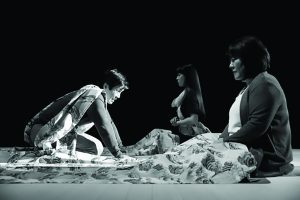 The Americans (and British, French, Dutch, and Russians) inevitably return, but Kayama’s brilliant ascent through the ranks of government continues. His friendship with Manjiro is the play’s emotional core and an ironic expression of its thematic thrust; as the Western influence increases, Kayama progresses from ingenuous traditionalist to worldly capitalist while Manjiro hardens from American apologist to reactionary nationalist.
The Americans (and British, French, Dutch, and Russians) inevitably return, but Kayama’s brilliant ascent through the ranks of government continues. His friendship with Manjiro is the play’s emotional core and an ironic expression of its thematic thrust; as the Western influence increases, Kayama progresses from ingenuous traditionalist to worldly capitalist while Manjiro hardens from American apologist to reactionary nationalist.
British director/designer John Doyle (last season’s hit revival of The Color Purple) made his name in the United States over the last decade with innovative Sondheim revivals, including equally stripped-down stagings of Sondheim-Prince collaborations, Sweeney Todd (1979) and Company (1970) in which the actors played their own instruments, and an intimate reimagining of Sondheim’s 1994 romantic weepie Passion in 2013, also at the Classic Stage Company. As in those mountings, Doyle has reduced the scenography to a single, bold image; in this case the stage, a combination scroll and hanamichi (the platform that connects the back of the auditorium to the stage in traditional kabuki), cuts right through the middle of the room. Costume designer Ann Hould-Ward has dressed her actors in simple modern clothing as well, suggesting the ongoing nature of Japan’s cultural integration.
Combined, the simple set and costumes return focus to where it should be in a Sondheim show: the score. In interviews, Sondheim tirelessly asserts that his shows only succeed because he successfully integrates his songs into his cowriters’ librettos, but in almost all of his musicals (excepting Company, Assassins, and maybe Sweeney Todd), the score far outshines the book.
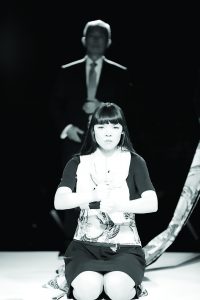 This is even more true than usual in this production of Pacific Overtures. The first act has always been the more engaging of the two, but Doyle has cut large portions of the book and two important musical numbers. This gives the evening a slender, audience-friendly running time of 90 minutes, but nudges the play even more toward the nonsensical. It begins to feel like the Reader’s Digest edition of the story, in which songs and scenes pile on each other without any provocation or narrative logic.
This is even more true than usual in this production of Pacific Overtures. The first act has always been the more engaging of the two, but Doyle has cut large portions of the book and two important musical numbers. This gives the evening a slender, audience-friendly running time of 90 minutes, but nudges the play even more toward the nonsensical. It begins to feel like the Reader’s Digest edition of the story, in which songs and scenes pile on each other without any provocation or narrative logic.
Sondheim is right in that sense: the works are so intricately constructed, the musical numbers so artfully integrated into the framework of the play, that any cuts or changes must be performed with immense care and craft to keep the whole structure from collapsing. The production also suffers from the strange preference accorded to the text in contemporary revivals. Hal Prince’s directorial and dramaturgical contributions were as much a part of the complex fabric of the show (a PBS recording of which is available on YouTube) as Weidman’s libretto and Sondheim’s score; without his grand unifying vision, the musical feels small and incomplete.
Perhaps the greatest casualty of the reckless cutting is Takei’s Reciter, a role embodied by Mako in the original production and B.D. Wong in the 2004 revival. A playful raconteur who moves in and out of the story, the Reciter is the connective tissue that gives the play the façade of a narrative through-line; here, his role has been condensed to the point of irrelevance (which may in part be due to his difficulty remembering lines). Doyle’s conceit of having the actors relate the story to actor Megan Masako Haley, who becomes a bemused but not entirely unwilling participant in the story briefly as well when she portrays Tamate, Kayama’s wife, is a nice touch that allows for a greater female presence in an overwhelmingly male piece, but makes the Reciter even more redundant.
The score remains one of Sondheim’s richest, and his gifts as a melodist have never manifested as clearly as in the melancholy, “There Is No Other Way,” which communicates both the thoughts and the words of the terrified Tamate as Kayama is about to leave to face the warships and foreshadows her seppuku, and “Poems,” in which Kayama and Manjiro build their friendship by trading lyrical lines as they travel. Beautiful, haunting melodies become sharp rhetorical weapons in Sondheim’s hands, as in the seductive “Pretty Lady,” which precedes a rape and murder. “Someone in a Tree,” a memory piece and Sondheim’s personal favorite of his songs, remains as trenchant and moving as ever.
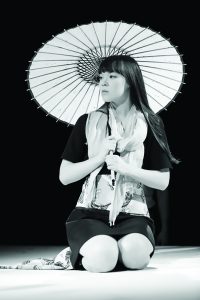 Pacific Overtures has certainly never been funnier. Ann Harada’s red-heeled Madam prepares her new recruits for the foreigners’ arrival in “Welcome to Kanagawa.” It’s one of Sondheim’s dirtiest songs, but he has expressed frustration in the past at never being able to make the sections in which the Madam explains sex positions painted on fans to her neophytes funny enough. He rewrites the song with every major new production, and has finally hit on the winning formula with this revival; the number inspires belly laughs. It helps that he has such winning comedic performers in Harada and breakout performer Loh, whose flustered novice is one for the ages. Loh brings the same performative acuity to all his roles here, and the play is richer for it.
Pacific Overtures has certainly never been funnier. Ann Harada’s red-heeled Madam prepares her new recruits for the foreigners’ arrival in “Welcome to Kanagawa.” It’s one of Sondheim’s dirtiest songs, but he has expressed frustration in the past at never being able to make the sections in which the Madam explains sex positions painted on fans to her neophytes funny enough. He rewrites the song with every major new production, and has finally hit on the winning formula with this revival; the number inspires belly laughs. It helps that he has such winning comedic performers in Harada and breakout performer Loh, whose flustered novice is one for the ages. Loh brings the same performative acuity to all his roles here, and the play is richer for it.
The play comes to life, in fact, any time he or Harada are given free rein to be funny or expressive. Doyle has directed the proceedings with a stateliness drawn from classical Japanese performance, which is appropriate. Yet, without the ultra-disciplined, precise technique garnered from a lifetime of dedicated training that characterizes traditional kabuki practice, that stateliness becomes stolid, staid, and sedate. Not only has the play been gutted into near-triviality, it has been tamed into a delicate artifact, almost too pacific to even make a ripple.
Comments by Advocate